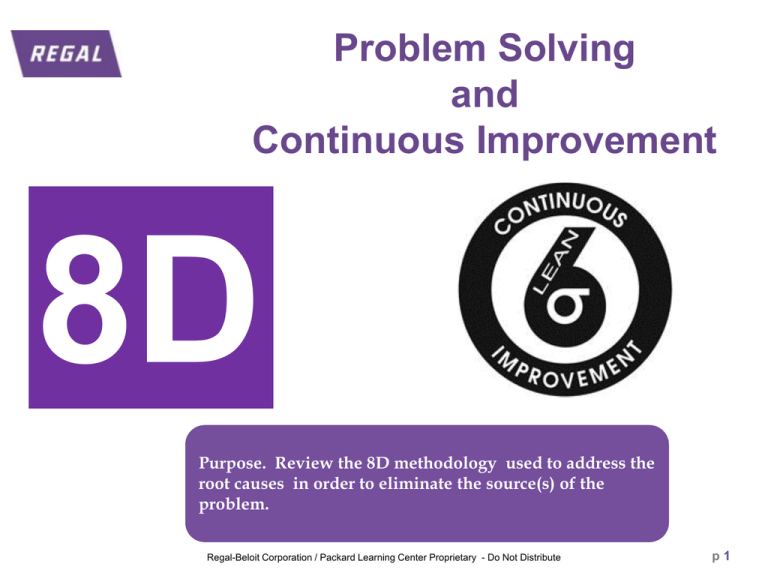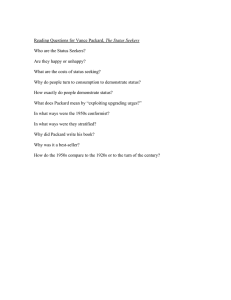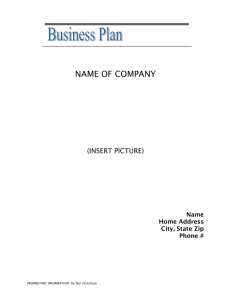Problem Solving
advertisement

Problem Solving and Continuous Improvement 8D Purpose. Review the 8D methodology used to address the root causes in order to eliminate the source(s) of the problem. Regal-Beloit Corporation / Packard Learning Center Proprietary - Do Not Distribute p1 Problem Solving and Continuous Improvement Find PoC ! Regal-Beloit Corporation / Packard Learning Center Proprietary - Do Not Distribute p2 Problem Solving and Continuous Improvement Regal-Beloit Corporation / Packard Learning Center Proprietary - Do Not Distribute p3 Practical Problem Solving Application Questions > What do you think is a problem? > What is actually happening? What do you actually know? Do you know enough to decide what it makes sense to do? Can you see what is happening? What should be happening? Can you break the problem down into smaller problems. > Can you see the point/area of cause? Do you need to track back to the point/area of cause? What is the pattern/tendency of the problem? • Where, When is it happening? • Who, What is involved? • How Much, How Long, How Often is it happening? Regal-Beloit Corporation / Packard Learning Center Proprietary - Do Not Distribute p4 Practical Problem Solving Application Questions > Why is this problem occurring?/What is its root cause? Can you find and confirm the direct cause of the problem? Can you find and confirm the next level of cause? Can you prevent recurrence of the problem by addressing the next level of cause? …..If not, continue asking Why? And conducting Cause Investigation until you find the root cause > What action(s) should you take to address the problem? What temporary measures will eliminate the problem until you can address the root cause? What countermeasures are needed to address root cause and prevent recurrence of the problem? > How will you check when you follow up to confirm results? Regal-Beloit Corporation / Packard Learning Center Proprietary - Do Not Distribute p5 “5 Why” Cause Investigation Questions (to find root cause) > Why is this problem occurring? Can you see the direct cause of the problem? If not, what do you suspect as potential causes? How can you check the most likely potential causes? How can you confirm the direct cause? > Do you need to ask Why? And continue Cause Investigation? Will addressing the direct cause prevent recurrence? If not, can you see the next level of cause? If not, what do you suspect as the next level of cause? How can you check and confirm the next level of cause? Will addressing this level of cause prevent recurrence? ….If not, continue asking WHY? Until you find Root Cause Regal-Beloit Corporation / Packard Learning Center Proprietary - Do Not Distribute p6 “5 Why” Cause Investigation Questions (to find root cause) – cont. > Have you found the Root Cause of the problem? Can you prevent recurrence by addressing this cause? Is this cause linked to the problem by a chain of cause/effect relationships that are based on fact? Does the chain pass the “Therefore” test? If you ask “Why?” again, will you be into another problem? Can you turn the problem on and then off? Regal-Beloit Corporation / Packard Learning Center Proprietary - Do Not Distribute p7 Fundamental Principles of Practical Problem Solving *Set aside pre-conceived ideas *See the abnormal occurrence and point of cause first hand *Delay cause analysis until you have a thorough grasp of what is actually happening *Establish cause/effect relationships based on fact not assumption *Continue asking Why? Until you can prevent recurrence of problem by addressing its root cause *Can the problem be turned on and then off? Regal-Beloit Corporation / Packard Learning Center Proprietary - Do Not Distribute the p8 Grasp Situation Initial Problem Perception WHERE? WHAT? Trackback P* PoC direct cause next level of cause P* = The real problem WHY? next level of cause next level of cause ROOT CAUSE CAUSE INVESTIGATION Regal-Beloit Corporation / Packard Learning Center Proprietary - Do Not Distribute p9 “5 Why?” Cause Investigation Abnormal Occurrence WHY? X (cause/effect relationship) Direct Cause C X WHY? X X (cause/effect relationship) X C Cause WHY? X (cause/effect relationship) X X C Cause WHY? X X (cause/effect relationship) Cause X C WHY? X X C ROOT CAUSE Regal-Beloit Corporation / Packard Learning Center Proprietary - Do Not Distribute p 10 How to Locate PoC - Exhaust System Case (1) Problem perception George feels the Design is an Obstacle! “This is a big Problem for me!” George (2) Grasp the Situation • What is actually happening? • What should be happening? Regal-Beloit Corporation / Packard Learning Center Proprietary - Do Not Distribute p 11 How to Locate PoC (3) Locate the Point of Cause • He feels this is a problem. But he can’t see the PoC. • To find the PoC, let’s track back this assembly line! George first picked up problem here Assembly flow 1 Observe Can see the Same abnormal occurrence 2 Trackback Observe Can see 3 Trackback Observe Can see Process 4 is the point of cause! Go back to 4 and observe 4 Trackback Observe 5 CAN NOT SEE Regal-Beloit Corporation / Packard Learning Center Proprietary - Do Not Distribute 6 p 12 How to Locate PoC 1.1. Problem Perception 2.2. Grasp the Situation ….draw the work flow to produce the report 1 2 3 4 5 7 10 6 11 8 9 Workflow Regal-Beloit Corporation / Packard Learning Center Proprietary - Do Not Distribute p 13 How to Locate PoC 3) Locate the Point of Cause (PoC) by Tracking Back from Final Product 1 2 3 4 5 7 10 6 11 8 9 Track back … look for points in process where mistakes first appear Regal-Beloit Corporation / Packard Learning Center Proprietary - Do Not Distribute p 14 8D Problem Solving Methodology 8D Supplier Training Purpose. Review the 8D methodology used to address the root causes in order to eliminate the source(s) of the problem. Follow step by step the 8D format and Prism 8D template to document the 8D and DO processes. Regal-Beloit Corporation / Packard Learning Center Proprietary - Do Not Distribute p 15 8D Process steps D0- Symptom & Response D8 Recognitions D7 Prevent Reoccurrence D1- Team 8 D D6i Implement Corrections D2- Problem D3- Containment D5- Define corrections D4- Cause and Escape Regal-Beloit Corporation / Packard Learning Center Proprietary - Do Not Distribute p 16 What is 8D? >8D is eight disciplines of Problem Solving >A disciplined process which addresses problem solving in: - A methodical and analytical method addressing root causes to eliminate the source(s) of the concern. >8D also refers to the form that is used to document the problem and resolution - Also called 8-D Report - Corrective Action Report - EW8D Report – East-West-8D Regal-Beloit Corporation / Packard Learning Center Proprietary - Do Not Distribute p 17 8D General Information - General Information - Supplier Material Rejection Information - Target Dates - Default Team Members Regal-Beloit Corporation / Packard Learning Center Proprietary - Do Not Distribute p 18 D0. Prepare for 8D D0- Symptom & Response D8 Recognition D7 Prevent Reoccurrence D6 Implement Corrections D1 Team D0 D5 Define Corrections D2 Problem D3 Containment D4 Cause & Escape Regal-Beloit Corporation / Packard Learning Center Proprietary - Do Not Distribute p 19 DO D0 Preliminary Data & ERA Generation >Collect information very shortly after defect was reported Using preliminary assessments to determine who, where, what , when . . . Look for the symptoms and generate the ERA > ERA: Emergency Response Actions Regal-Beloit Corporation / Packard Learning Center Proprietary - Do Not Distribute p 20 D1 Form the Team D0 Symptom and Response D8 Recognition D7 Prevent Reoccurrence D1 Team D1 D6 Implement Corrections D2 Problem D3 Containment D5 Define Corrections D4 Cause and Escape Regal-Beloit Corporation / Packard Learning Center Proprietary - Do Not Distribute p 21 Why use a team? > Working as an individual is often less proficient > Working in a group maximizes the potential output > Opportunity to select people with process and product knowledge. > Working in a group maximizes the potential output Regal-Beloit Corporation / Packard Learning Center Proprietary - Do Not Distribute p 22 Team Selection Forming the team: >Select the member based on their skills Process knowledge Product Knowledge Communication skills Data analysis skills >Select multidisciplinary team Engineering Production Quality Maintenance It’s your team pick the best people! Others Regal-Beloit Corporation / Packard Learning Center Proprietary - Do Not Distribute p 23 D1 - Steps to follow >Define team members role Champion ( Assigned person or Supplier) Leader ( Regal) D1 Team Members Regal-Beloit Corporation / Packard Learning Center Proprietary - Do Not Distribute p 24 D2 Problem Definition D0 Symptom & Response D8 Recognition D7 Prevent Reoccurrence D1 Team D2 D6 Implement Corrections D2 Problem D3 Containment D5 Define Corrections D4 Cause and Escape Regal-Beloit Corporation / Packard Learning Center Proprietary - Do Not Distribute p 25 D2 - Describe the problem D2 An adequate problem description = at least 50% of its solution Regal-Beloit Corporation / Packard Learning Center Proprietary - Do Not Distribute p 26 D3 Containment actions D0 Symptom & Response D8 Recognitions D7 Prevent Reoccurrence D1 Team D3 D6 Implement Corrections D2 Problem D3 Containment D5 Define Corrections D4 Cause and Escape Regal-Beloit Corporation / Packard Learning Center Proprietary - Do Not Distribute p 27 D3 D3 - Interim Containment Action > Actions to contains the effects of the problem must be done > Urgent Actions to avoid customer dissatisfaction must be carried out Regal-Beloit Corporation / Packard Learning Center Proprietary - Do Not Distribute p 28 D3 Interim Containment Action This is stage where containment actions are taken to prevent the escalation of the problem. >The containment action could include: 100% inspection Stoppage of production / shipment Substitute process Rework Field service action Regal-Beloit Corporation / Packard Learning Center Proprietary - Do Not Distribute p 29 D4 Root cause D0 Symptom & Response D8 Recognition D7 Prevent Reoccurrence D1 Team D4 D6 Implement Corrections D2 Problem D3 Containment D5 Define Corrections D4 Cause and Escape Regal-Beloit Corporation / Packard Learning Center Proprietary - Do Not Distribute p 30 Root Cause Analysis D4 When root cause is identified, the problem can be turned off Regal-Beloit Corporation / Packard Learning Center Proprietary - Do Not Distribute p 31 Verification & Validation > Verification and Validation are often not well understood. Verification and Validation work together as a sort of ‘before’ (Verification) and ‘after’ (Validation) proof. Verification provides ‘insurance’ at a point in time that the action will do what it is intended to do without causing another problem. Predictive. Validation provides measurable ‘evidence’ over time that the action worked properly. CJ Kurtz & Associates LLC Regal-Beloit Corporation / Packard Learning Center Proprietary - Do Not Distribute 32 Verification & Validation Step Process Purpose Verification That the “containment action” will stop the symptom from reaching the customer. D3 Validation D4 Verification That the real root cause is identified D5 Verification That the corrective action will eliminate the problem D6 Validation That the containment action has satisfactorily stopped the symptom from reaching the customer according to the same indicator that found it. That the corrective action has eliminated the problem according to the same indicator that found the issue. CJ Kurtz & Associates LLC Regal-Beloit Corporation / Packard Learning Center Proprietary - Do Not Distribute 33 D5 - Define Corrections D0 Symptom & Response D8 Recognition D7 Prevent Reoccurrence D1 Team D5 D6 Implement Corrections D2 Problem D3 Containment D5 Define Corrections D4 Cause and Escape Regal-Beloit Corporation / Packard Learning Center Proprietary - Do Not Distribute p 34 Permanent Corrective Actions >For this activity we have to consider two levels of need: Given: those criterion that must be met and that are measurable and realistic to achieve. D5 Wants: Those criterion that are nice to have but not necessary critical. Regal-Beloit Corporation / Packard Learning Center Proprietary - Do Not Distribute p 35 Permanent Corrective Actions MUST: > Eliminate the root cause > Prevent recurrence > Be implemented in a timely manner > Be objectively verified > Be effective Regal-Beloit Corporation / Packard Learning Center Proprietary - Do Not Distribute p 36 D6 - Implement & Validate C/As D0 Symptom & Response D8 Recognition D7 Prevent Reoccurrence D1 Team D6 D6 Implement Corrections D2 Problem D3 Containment D5 Define Corrections D4 Cause and Escape Regal-Beloit Corporation / Packard Learning Center Proprietary - Do Not Distribute p 37 D6 Validate Permanent Corrective Actions (PCA) >For this activity we have to consider: D6 Verify the permanent corrective actions as they were documented Measure the effectivenesss of the permanent corrective actions Regal-Beloit Corporation / Packard Learning Center Proprietary - Do Not Distribute p 38 Validation Tools Trend Chart Pareto Chart Is / Is Not PFMEA Chi Square 3 Leg 5 Why Regal-Beloit Corporation / Packard Learning Center Proprietary - Do Not Distribute p 39 D6 Implement Permanent Corrective Actions (PDCA) Choose and implement PDCA use the Deming Cycle. >Plan: • The implementation of the PDCA. • Plan for validation • Plan to continue monitoring the effectiveness. >DO: Initiate the implementation >CHECK: Check the PCA has been fully implemented >ACT: Take actions on any variation from the plan Regal-Beloit Corporation / Packard Learning Center Proprietary - Do Not Distribute p 40 D7 Prevent Reoccurrence D0 Symptom & Response D8 Recognition D7 Prevent Reoccurrence D1 Team D7 D6 Implement Corrections D2 Problem D3 Containment D5 Define Corrections D4 Cause & Escape Regal-Beloit Corporation / Packard Learning Center Proprietary - Do Not Distribute p 41 D7 - Prevent Reoccurrence D7 You can consider apply the permanent corrective actions to other processes, area or products. Regal-Beloit Corporation / Packard Learning Center Proprietary - Do Not Distribute p 42 D7 Prevent Reoccurrence Identify and implement steps that need to be taken to prevent the same or similar problem from occurring in the future. > Modify specifications, PFMEA, Control Plan, etc. > Update training > Review workflow & process flow > Improve management system, operating system, practices and procedures Regal-Beloit Corporation / Packard Learning Center Proprietary - Do Not Distribute p 43 D8 Congratulate the Team D0 Symptom & Response D8 Recognition D7 Prevent Reoccurrence D1 Team D8 D6 Implement Corrections D2 Problem D3 Containment D5 Define Corrections D4 Cause and Escape Regal-Beloit Corporation / Packard Learning Center Proprietary - Do Not Distribute p 44 8D - Formal Closure D5 Team members efforts grow with the recognition Regal-Beloit Corporation / Packard Learning Center Proprietary - Do Not Distribute p 45 Congratulate Team The final step in a team oriented problem solving effort is to recognize the teams >How to congratulate the team • Review significance of contribution • Provide appropriate recognition • Celebrate successful completion Regal-Beloit Corporation / Packard Learning Center Proprietary - Do Not Distribute p 46 8D Closure Check Points Supplier must ensure the changes in following documentswherever required > Photographs of the evidences (Preferably Before & After Photographs) > Process Flow Diagram > SOP’s > FMEA > Control Plans > Update PPAP documents, PSW Approvals (Wherever applicable) Regal-Beloit Corporation / Packard Learning Center Proprietary - Do Not Distribute p 47 8D - Shipping Instructions Product/Process Changes > Product/Process changes for corrective actions/improvements due to 8D, Quality issue or Engineering change: > Shipping Requirements: Supplier must ensure that all material skids/bins must be tagged before shipment with Bright Green Tags on (2) sides as “Certified Material”. The shipping documentation and or certification tags must contain at a minimum; part number, revision level and mfg. date. and change(s) made Regal-Beloit Corporation / Packard Learning Center Proprietary - Do Not Distribute p 48


